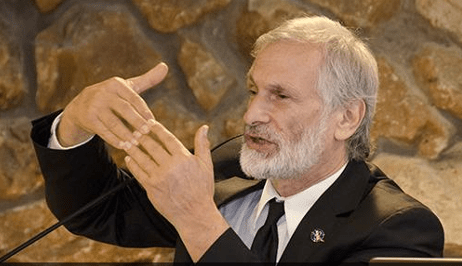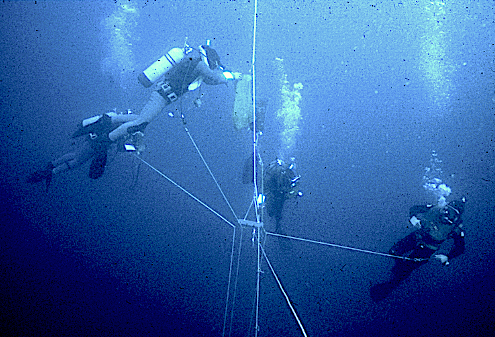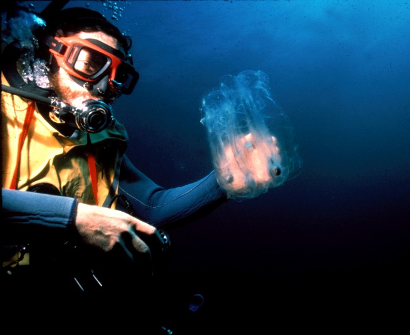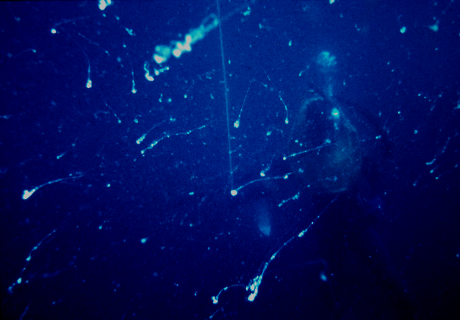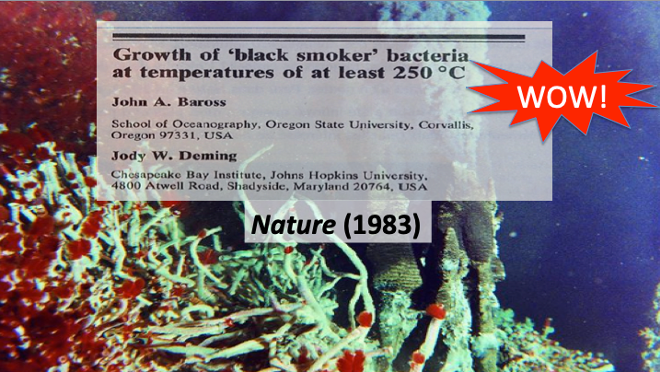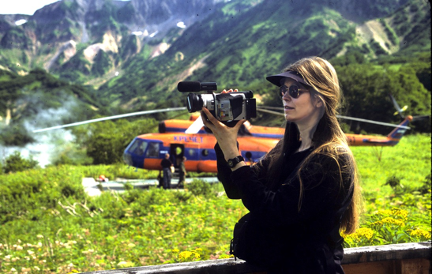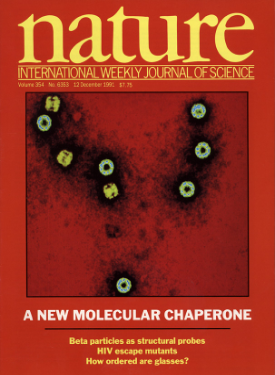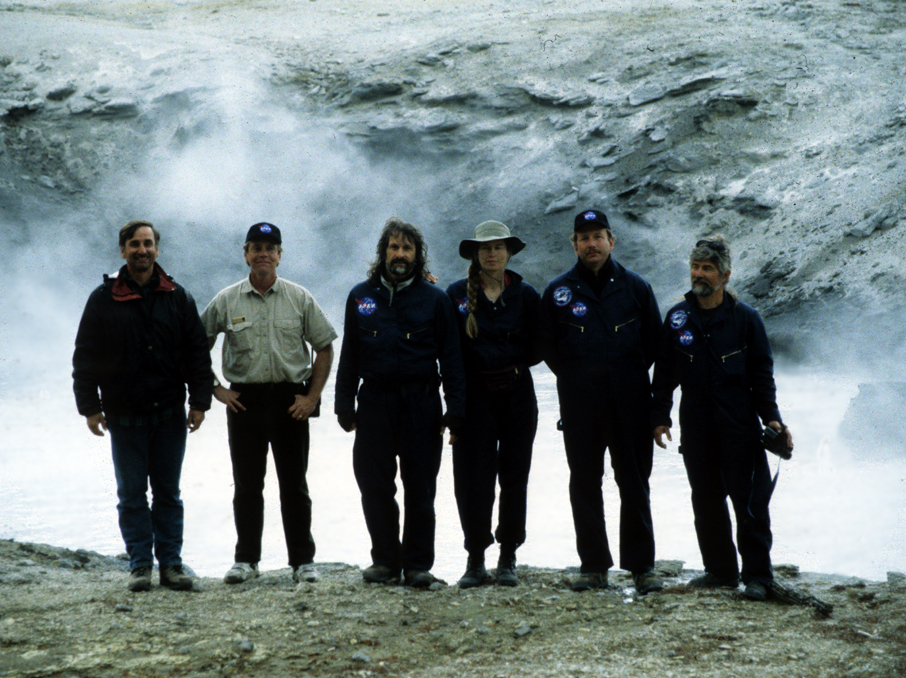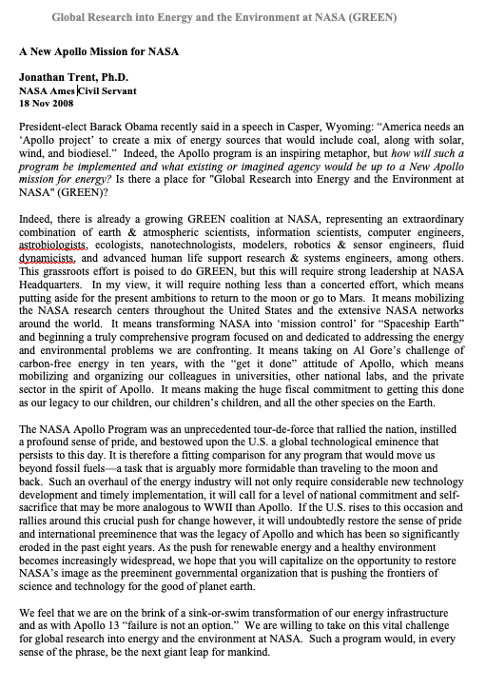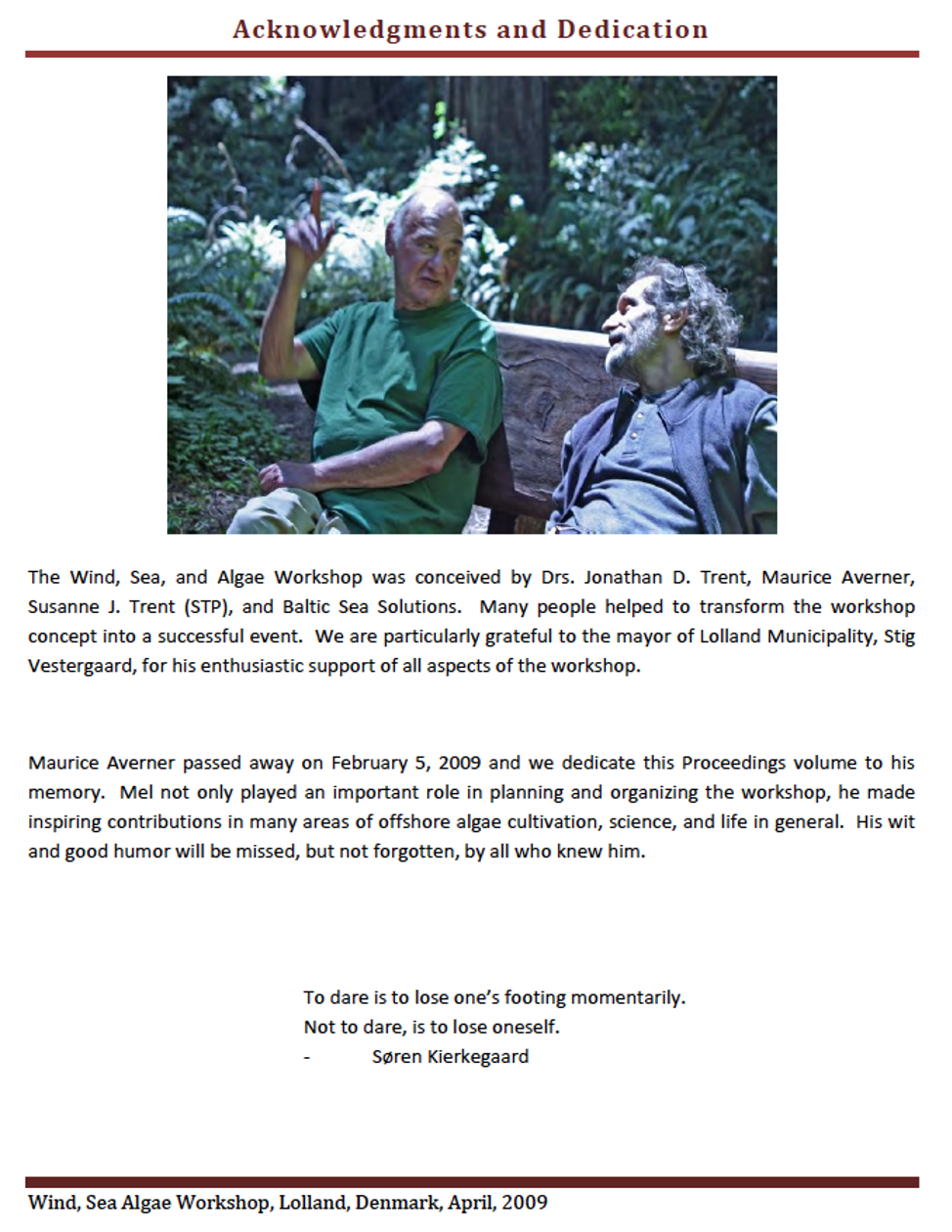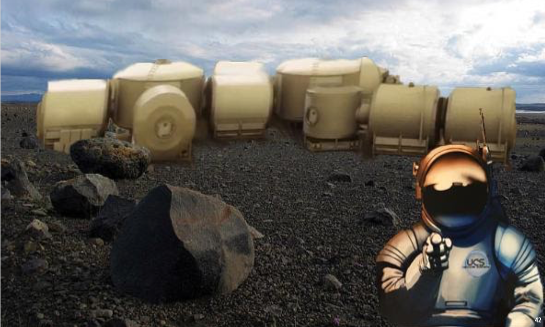We generally start these interviews with your youth, even your childhood, where you were born, your family, your early years and specifically if there was anything in those years that may have gotten you pointed toward where you are now in terms of your career.
This is a big topic and while all of it can be somehow mapped to my path to NASA, I’ll spare you the detail, but tell you about an interesting “red thread” that ultimately got me into a relationship with NASA… The one, particularly relevant feature of my youth that was critical to my scientific career, was my early and lifelong fascination with the ocean. This led me to become a SCUBA diver when I was quite young, which became an important part of my scientific development as an undergraduate at UC Santa Cruz (UCSC). I was an undergrad in the early 1970s and as fate would have it, there were some unbelievably inspiring marine science professors at UCSC at that time. Chief among them was John Pearse, who introduced me to the amazing world of invertebrate zoology in his classroom and took me sightseeing in his “Subtidal Ecology” course in the kelp beds at Hopkins Marine Station in Pacific Grove. It was John Pearse who taught me the names of the “thousand thousand slimy things” that I had seen all those years while diving. Just knowing their name significantly enriched my relationship with these creatures, but John and his wife Vicki, who is also an invertebrate zoologist, both had a gift of communicating the secret lives of these invertebrates. They talked about these animals with a familiarity that only deepened my curiosity. In hindsight, it was John and Vicki and other UCSC mentors (Ken Bruland, Bill Doyle, Ken Norris, and Mary Silver come to mind), who turned my childhood fascination with the ocean into science. They taught me to do science with enthusiasm and rigor, two things I have aspired to maintain my whole career.
It was Mary Silver, who introduced me to the plankton and to thinking about the open ocean which is an important part of my story. A few of my diving buddies from John’s sub-tidal ecology course, (Alan Shanks, John Mattison, Tom Aiken), and I had the idea that we could use SCUBA to study the plankton in the open ocean. We were crazy enough to take a small (5.9 m) Boston Whaler miles offshore in Monterey Bay to do what became known as “blue water research diving.”
As you can imagine, I can tell many stories about my blue water research diving experiences, but following that “red thread” to NASA, the key point is that this research in Monterey Bay led to a high-profile publication in “Science” on marine snow (Silver, M.W., A.L. Shanks, and J.D. Trent. 1978. Marine snow: Microplankton habitat and source of small-scale patchiness in pelagic populations. Science 201: 371-373). My “marine snow” research is relevant to the NASA story, so let me elaborate this a bit…
Marine snow, which was first seen from submersibles, turns out to be aggregates of the small plant and animal plankton held together by any “sticky junk” that’s in the water. These amorphous aggregates are fragile and while they were seen from submersibles, the submersible divers couldn’t sample them with the awkward mechanical arms of the early submersibles. The marine snow was sampled in the nets and bottles used by traditional marine scientists on ships, but because it was so fragile, it disintegrated during sampling and couldn’t be studied for what it was in the water. Ah ha, so here we were SCUBA diving in the middle of Monterey Bay frequently surrounded by marine snow “storms” and we studied that stuff with enthusiasm and rigor…
With regard to my NASA story, our marine snow research in Monterey Bay got Alan Shanks and I invited to Scripps Institution of Oceanography to become part of John Isaac’s Foundation for Ocean Research (FOR). Fresh out of our undergraduate degrees, Alan and I moved to San Diego and worked at Scripps as “research associates” for a couple of years before becoming graduate students there to get our Ph.D.’s in marine science.
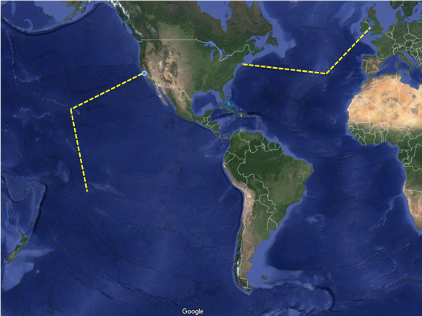
I spent nine years doing blue-water diving, on cruises in the San Diego Bight, and on expeditions from San Francisco to Hawaii and then on to Tahiti and from Woods Hole to the Azores and then on to Scotland.
In hindsight, it was crazy dangerous to put me at risk diving in the open ocean, but it was for science and you understand, it was back in the days when NASA did Apollo for science. Now we have such sophisticated robotics it makes no sense to put people at risk for such things, but I must say my blue-water-diving buddies and I had some amazing experiences and we published some important papers. I also curated an exhibition of some of the photos we took of the bizarre open-ocean organisms we encountered. I called it: “UFOS: Unfamiliar Fauna of the Open Sea,” and it became part of the Smithsonian Institutions Traveling Exhibition Series (SITES) for five years. Now, most of the photos hang at Moss Landing Marine Lab…
But I digress, it was not UFOS that led me to NASA…
So, can you make a connection between your marine biology pursuits, which sound marvelous, to how you wound up at NASA?
Yes, I was getting to that. It was based indirectly on my marine snow research. Let me explain… As I said the marine snow is aggregates of bacteria, tiny plants and animals, and random “sticky junk” more scientifically called “detritus.” We observed that these marine snow aggregates are sinking, which has important consequences for the ocean but also as you’ll see, it is part of my red thread to NASA.
As the marine snow sinks to greater and greater depths, the temperature of the water goes down and the pressure goes up. You know, the ocean is mostly heated at the surface and gets colder with depth and the pressure increases with the weight of the overlying water. Pressure increases by 1 atmosphere (1 bar) for every 10 meters of depth…
Okay, but how does this connect to your path to NASA.
It’s coming, you’ll see… At Scripps, I was working in a lab that studied microbes collected from the deepest parts of the ocean–the bottom of the Mariana Trench, where the temperature is about 4°C and the pressure is 1,100 bars that’s 1,100x higher than what we’re experiencing here and now. To grow these bacteria required specialized low temperature and high-pressure equipment. I was using this equipment for part of my marine snow research, simulating the temperature and pressure effects on microbes that could be living on marine snow particles sinking from the surface into the deep sea…
Okay, I told you that in general, the deep ocean is cold, the average temperature is 4°C, and high pressures, average bottom pressures are about 380 atmospheres. There are some rare exceptions, however. These are places in the deep ocean with underwater hot springs–the so-called “hydrothermal vents.” These vents of hot water are very hot “hot springs” because the high pressures keep the water from boiling. I think the maximum temperature they can reach is about 420°C, which is the critical temperature for seawater.
So what does this have to do with my NASA story?
In the late 1970s, submersible divers observed remarkable communities of animals living around the deep-sea hydrothermal vents near the Galapagos. And it was discovered that some of the animals in this deep-sea vent community are using the chemistry from the vent fluids for a process called “chemo-auto-trophy.” In other words, they form an ecosystem based on geochemistry rather than sunlight. (Doesn’t this start to sound a bit more like a NASA story? Think about Jupiter’s moon Europa).
Well, the big question on everyone’s mind at the time was whether any of these deep-sea hydrothermal vent organisms could actually live in the super hot water? Were they super organisms setting new records for high-temperature life or were they just living near the hot vents, like people sitting around a campfire at the right distance to take advantage of the heat but not too close to be burned?
So here’s how I got involved in this… It’s 1983 and I’m doing my graduate-student research in this lab at Scripps with high pressure and low-temperature equipment. Along comes John Baross, a young professor of microbiology from Oregon State University, and he has samples from a hydrothermal vent off the coast of Mexico. This was a super-hot vent with black fluid coming out at over 300°C. The fluid was black because of the metal sulfides that precipitated as the vent fluid-cooled in the deep seawater and appeared as black billows, which led to the name: “Black Smoker.”
John wanted to simulate the high temperature and high-pressure conditions in the black smokers to test the hypothesis that his samples contained microbes that could grow at higher temperatures than anything ever observed. Creating such a high temperature/high pressure culturing apparatus was a bit of a challenge, but not so different from what we already had in the lab and the technician, Ron VanBoxel, was a genius at creating such specialized equipment. It wasn’t long before Ron had created a “black smoker simulator” that could reach temperatures up to 300°C and 265 bars of pressure and John, working with the postdoc in the lab, Jody Deming, started experiments.
I was not collaborating with them, but I was getting regular updates about their exciting progress, which culminated in a paper entitled: “Growth of ‘black smoker’ bacteria at temperatures of at least 250°C” which was published in “Nature.”
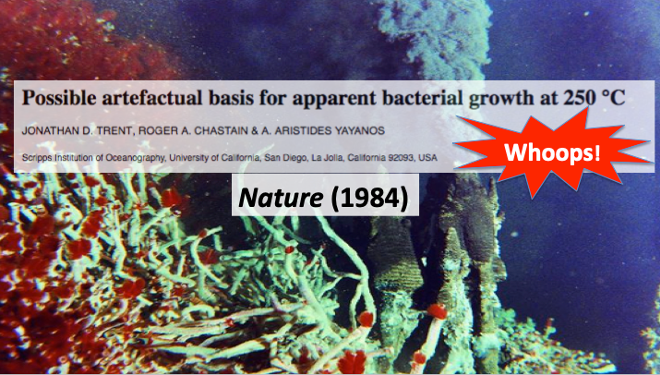
Wow! This more than doubled the maximum temperature for life and invited wild speculations about life deep underground and on Venus. The discovery of “black smoker bacteria” was hailed as one of the “seven wonders of the modern world.” It made John Baross and Jody Deming famous…The only problem was that there were no black smoker bacteria growing at 250°C and it was all a mistake–Whoops!
Remember the Carl Sagan quote: “Extraordinary claims require extraordinary evidence.” Well, bacteria growing at 250°C was an extraordinary claim, but the supporting evidence to prove their existence was unfortunately not extraordinary. In fact, John and Jody had failed to do critically important control experiments to be sure their results were real and not just some kind of experimental artifacts. Driven by curiosity I got another graduate student, Roger Chastain, to work with me to do those missing control experiments using Ron’s “Black Smoker” apparatus. Unfortunately for John and Jody, we discovered “extraordinary artifacts” formed under the experimental conditions they use. In other words, we showed that their evidence for “Black Smoker” bacteria could be explained by artifacts that appeared spontaneously at high temperature and pressure and what they saw was no bacterial growth. To put it more bluntly, there was a more plausible non-biological explanation for their observations and “black smoker bacteria” were BS bacteria!
I wrote about this whole experience in a popular paper entitled “In the realm of phonions and confuzoa,” published in La Recherche (1999) and I talked about this experience in a TEDx talk in Palo Alto in 2017.
This confirmed Thomas Huxley’s famous observation about the “great tragedy of science–the slaying of a beautiful hypothesis by an ugly fact.” But the point of this for my NASA story is that it was this experience that got me excited about the question: What is the upper-temperature limit of life? A question that opened doors for me to a number of wonderful postdocs’s in some great lab’s and that ultimately led to my becoming part of NASA’s Astrobiology program, which posed precisely that question about the limits to life in the universe …
I should say a few words about my mostly wonderful Postdocs.
Immediately after I graduated from Scripps, I moved to Germany to do a postdoc with Wolfram Zillig at the Max Planck Institute for Biochemistry in Munich. Herr Dr. Zillig was involved in isolating some of the highest temperature microbes in the world and I became part of his research team. We went on some amazing expeditions to geothermal areas in Italy, Sicily, and the Azores.
After my time in Germany, I went to work with Roger Garrett at the University of Århus and later at the University of Copenhagen in Denmark. In Copenhagen, I met Susanne Johansen, who not only became my wife, she became my research partner as a photographer and videographer, project manager, advisor, confidant, and all-around great life-partner. Susanne and I went together from Copenhagen to Paris, where I worked with Patrick Forterre at the University of Paris at Orsay, France.
During these Postdocs, positions, and expeditions, I developed skills in sampling and cultivating organisms living in extreme environments, the so-called “extremophiles.” I also delved into molecular biology and biochemistry to try to understand the biological adaptations of the specific extremophiles that live in near-boiling sulfuric acid. I focused most of my extremophile research on a very interesting group of proteins called “heat shock proteins” (HSPs) and more specifically the 60-kilodalton heat shock proteins (HSP60s) that were believed to somehow help organisms adapt to heat stress. The HSP60s are said to be “highly conserved,” which means they are present and almost identical in nearly all organisms. This indicates they are doing something pretty important and as the name “heat shock” suggests, it may have something to do with temperature adaptation.
I was the first person to investigate if organisms growing at high temperatures have HSP60s. It turned out to be harder than I thought it would be, but it also turned out to be very rewarding. I began this research at the Max Planck Institute in Germany and continued at the Universities in Denmark and France, but it wasn’t until I returned to the US to work at the Boyer Center for Molecular Medicine at Yale Medical School that I finally identified the HSP60 from the extremophile I had started studying in Germany. It was at Yale that I finally characterized the extremophile HSP60, four years after I started working on this project in Europe, and to my surprise and deep satisfaction, I discovered that this protein was far more interesting than anyone expected. It turned out that the extremophile HSP60 was only distantly related to the well-known bacterial extremophile HSP60 protein, but closely related to a human protein originally found in mice and called “Tailess Complex Polypeptide 1” or TCP1.
It was satisfying that my four years of research resulted in a publication that was hailed as a breakthrough for the “molecular chaperone” theory and published in “Nature” with a picture of the extremophile HSP60 complex on the cover (Trent et al. 1991, vol. 354, pp. 490-493). While everyone believed at the time that my results supported the molecular chaperone theory, I should mention that my continued research on extremophile HSP60s ultimately contradicted this interpretation. My later work showed that the location of extremophile HSP60s in cells undermines the molecular chaperone theory; alas, once again a “beautiful theory destroyed by ugly facts,” But so be it, I’m proud that my scientific career has always focused on facts no matter how “ugly” or iconoclastic and disruptive they are to some…
Let’s get back to my path to NASA. I’m almost there.
I left Yale to establish a biotechnology group at the Department of Energy’s Argonne National Laboratory in the greater Chicago area. At Argonne, I continued my basic research on extremophiles, exploring how these robust organisms could help clean up some of the hazardous environmental wastes the DOE had accumulated over the years.
Did you propose to a NASA solicitation to do this kind of work at Argonne and is that how you got to NASA? If so, how did you get to NASA Ames?
Good guess, but not quite. I think I got onto NASA’s radar because in the late 1990s the Astrobiology concept was gaining momentum at NASA and one of my old professors from Scripps, Ken Nielsen, took a position leading the Astrobiology effort at the Jet Propulsion Lab (JPL). He knew about my work on extremophiles and wanted me to join him at JPL. Ken arranged for me to meet people from NASA and learn about topics in astrobiology by sitting on a review panel for “exobiology” at the Lunar Institute in Texas. It was there that I met Sherwood Chang and Kevin Zahnle from NASA Ames. They not only told me about the astrobiology program at Ames, they suggested there could be a “hard money” civil servant position available in that program for someone like me. So, I knew the JPL position was “soft money” and after 5 years at Argonne National Lab, I knew what it meant to be on soft money, writing grant proposals all the time to support everybody in the lab, including myself. The idea of a salaried civil servant position appealed to me, but it was really Susanne who convinced me that working at NASA would be a step forward in my career and that NASA Ames in the Bay Area would be a better place for us to live than near JPL in Pasadena.
There were many reasons to come back to my home state of California, including living close to my mother who lives in Santa Cruz. I should also mention my Japanese Postdoc and collaborator at Argonne, Hiromi Kagawa. Hiromi had come from Japan to work with me at Argonne in 1993, but her husband, Masahito, who initially remained in Tokyo for his work as a computer engineer had moved to Silicon Valley. So my accepting the position at NASA Ames in addition to being a hard-money position that allowed Susanne and me to continue collaborative fieldwork and live in a beautiful place we both liked not far from my mother; it also allowed Hiromi and Masahito to finally live together and start their family.
It was in Sept of 1998 that I became a civil servant at NASA Ames as part of the astrobiology program under Harry McDonald as Center Director and David Morrison as the Code-S Director.
Do you know the first astrobiology project I did at NASA Ames? Did it involve searching for MONSTERs?
I think I read about it in your tech brief but refresh my memory.
We used rugged underwater cameras to search for “Multi-cellular Organisms Not Seen by Traditional Environmental Researchers” (MONSTERs).
That’s a great acronym!
(Laughs) Thanks. The idea was to look for macroscopic organisms in the hot springs using a modified sewer-pipe inspection camera. I had a great team for that project which included Susanne, of course, and two NASA engineers, Fred Martwick and Charlie Friedericks, who could build anything and make it work. The idea was that perhaps organisms are lurking in the hot water underground that are “smart” enough and fast enough to avoid traditional sampling devices, but we’d be able to see these MONSTERs using our video camera. It was an interesting idea and we took some of the first-ever underwater-videos of many remote hot springs in the rugged backcountry of Yellowstone National Park. This in itself was groundbreaking and fascinating.
In addition to Yellowstone, my Astrobiology research on extremophiles took my research team and me to Mount Lassen hot springs in California to collect samples–another incredible place. We were also part of an Astrobiology expedition to the Kamchatka Peninsula in the Russian Far East. You can see what we did in Kamchatka in Susanne’s video.
Caption: Nearly the size of California, the Kamchatka Peninsula in the Russian Far East has few roads and the NASA Astrobiology Team visited many hot spring areas by helicopters and off-road vehicles. Our Russian colleagues were our guides and we took only pictures and left only footprints. Video by Susanne Johansen Trent.
In my early days at NASA Ames, I worked with the Ames Astrobiology team, Greg Schmidt and Lynn Harper, to educate people at NASA HQ and politicians in Washington, DC. I remember a DC trip we made to do a presentation in the Senate chambers about Astrobiology in which I talked about the MONSTER project. It was interesting to be speaking to Senators about extremophiles, but a bit disillusioning to see that most of our politicians are lawyers and they were more impressed by the “MONSTER” acronym than by the science. Oh well…
Soon after I arrived at NASA Ames, Don DeVincenze, a Code S Division Chief, asked me to talk at their management retreat about my career experiences. I remember I took that opportunity to characterize each place I’d worked in terms of its “purpose,” what constituted “success,” and the roles of the “scientists and managers.” So for example, the “purpose” of the University of Copenhagen was education; success was graduating satisfied and proud students, and the role of the scientist was first and foremost as a teacher using research as a teaching tool, while the role of the University managers was to oversee the bureaucracy that kept the University running smoothly.
It was different at both the Max Planck Institute and the Boyer Center at Yale, where the purpose was research, success was measured by the number of publications in high profile journals, the role of the scientist was to be creative and effective in research, and the role of managers was to support the scientists to facilitate their research–she or he should not be bogged down with bureaucracy.
In contrast, at Argonne National Lab, the purpose was to anticipate and fulfill the changing needs of the DOE. Success was measured by the amount of money obtained from DOE and other funding sources, and the role of the scientist was to write proposals and papers that would help get proposals funded or to become managers if they failed to get funding. The role of the Argonne managers, who were mostly scientists who didn’t get grants funded any longer, was to push the scientists to write proposals, fire scientists who failed to get funding and hire people doing the new-new thing that they thought DOE may like…
I remember at the end of my presentation a colleague, Lou Allamandola, came up to me to wish me luck, insinuating that there may be tough times for me ahead at NASA Ames. This was a bit disturbing, but the best thing that came out of my presentation that day was that I met Karen Bunn, Deputy Branch Chief. She told me emphatically that I needed to transfer from the Exobiology branch to Mark Kliss and her branch where she could help me. I did transfer to their branch and Karen helped me enormously for years, until she retired. Karen knew the ins-and-out of Ames and her incredible help allowed me to focus on science and research and not be overwhelmed by the NASA bureaucracy.
Yeah, thinking back on the science I did during my 21 years at NASA Ames, it was so rewarding, in part, because it kept changing and evolving. For example, I mentioned already that I arrived in 1998 to be part of the astrobiology effort and already about a year later I began working on Nanotechnology. You may not recall, but at the time, there was a lot of hoopla about nanotechnology and the interesting properties of carbon nanotubes. There was a “Nanotechnology Center” developing at Ames led by Meyya Meyyappan and a lot of money was being invested. I remember thinking that everything in molecular biology is on the nano-scale and way more interesting than just carbon nanotubes. I went to the Center Director, Harry McDonald, and said, “You’re investing in carbon nanotubes, which is all well-and-good, but it’s only carbon–it’s glorified soot… Think what molecular biology has taught us about using molecular recognition and self-assembly, combined with genetic “engineering” through mutations and selection, I mean biology makes nano-structures that ultimately create such amazing things as whales, redwood trees, and human consciousness.”
What happened?
Well, Harry was sufficiently impressed to give me some “Director’s discretionary funds” so I could start the “Protein Nanotech Group.” Hiromi and I worked together on this and I hired two civil servants, Andrew McMillan and Chad Paavola. I also hired a great postdoc, Yifen Li, and a super technician, Susan Chan. There were many wonderful students, interns, and visiting scientists over the years and together we did some great projects. I won’t go into details here, but just, for example, we genetically engineered my favorite extremophile HSP60 proteins that naturally self-assemble into a double ring structure called a “rosettasome.” We engineered the proteins so each rosettasome would bind a magnetic nanoparticle in its core (see Figure). We then found conditions that made the rosettasomes spontaneously arrange themselves into 2-dimensional crystals–perfectly ordered sheets of rings with tiny magnets in their cores. And then, by “burning” away the proteins and leaving the tiny magnetic particles annealed to a surface, voila! We created a self-assembling, protein-templated data-storage device that could hold nearly a terabyte of data per square centimeter. We spoke to Hitachi’s data storage division about this and they were excited about doing a project with us, but NASA-legal had issues with us working with a foreign company and it didn’t work out. But although we didn’t actually make the device, we demonstrated that it is feasible and how cool was that?
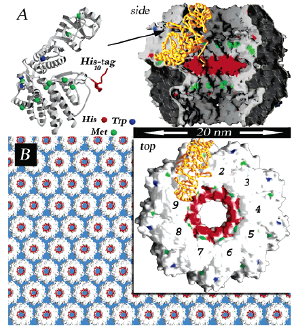
(right, cross section side and top-views) with a 10 nm diameter core genetically functionalized with Histidine tags. These rings self-assemble into hexagonally packed 2D sheets that we used to pattern nano-particles. J. AM. CHEM. SOC. 2005, 127, 2800-2801
This is just one example. There were many interesting protein nanotech projects and I got the 2006 “Nano-50 award” for innovation. It was an exciting time for me scientifically that led to what I consider my most important work.
Okay, please elaborate, but be brief.
Well, what I consider my most important work emerged indirectly from the part of my nanotech research that was focused on creating self-assembling enzyme systems. Let me explain this a bit. You know that enzymes facilitate chemical reactions and by “systems” I mean combinations of enzymes arranged on nano-structures that could do multi-step chemical conversions. In other words, we were trying to create an assembly-line of enzymes that could do interesting things.
There are loads of examples of multi-enzyme cascades in nature that do amazing things. Think of any metabolic pathway or biological process; there are always loads of enzymes involved, working together or sequentially.
As a proof-of-concept, we chose to build a multi-enzyme system that could degrade cellulose. We picked cellulose degradation for a number of reasons: 1) Cellulose is the most abundant polymer on earth, 2) It was the focus of a lot of research for making biofuels and other important products, and 3) Nature provided us with an excellent model system called a “cellulosome” that is a bacterial nano-structure with different cellulose-degrading enzymes attached by special linkers to a molecular scaffold. We did the obvious thing; inspired by bio-mimicry, we borrowed these linkers from the cellulosome and genetically installed them on rosettasomes from our extremophile, so it could accommodate the cellulosome enzymes. This worked wonderfully and we succeeded in creating a multi-enzyme complex we called a “Rosettazyme” that actually worked.
In other words, we successfully designed, genetically engineered, and built rosettazymes that were self-assembling, multi-enzyme arrays that degraded cellulose. It was an elegant proof-of-concept, but it turned out not to be practical for industrial cellulose degradation. This industry is not particularly interested in “elegant” solutions. They want cheap solutions and currently use “cocktails” of super cheap fungal enzymes to degrade cellulose. Oh well, we were “casting pearls before swine.”
But wait, there’s more to this story…
It was 2007, and climate change issues were sharpening the discussions about alternative energy. Cellulose was part of the alternative energy discussion because it could be used to make biofuels and with our rosettazyme research, I was paying attention to all of this…
At the time, Google or rather Larry Page and Sergey Brin were looking for ways to collaborate with their neighbors at NASA Ames and put out a call for proposals. I proposed a project called “Sustainable Energy for Space Ship Earth.” What I was proposing was to take a deep-dive into ways to make biofuels and more generally to explore what NASA could contribute to alternative energy research and the pressing environmental issues. I proposed “Global Research into Energy and the Environment at NASA” (GREEN).
It was with this “Google” funding that I formed the GREEN Team, which led to the GREEN seminar series with such prominent speakers as Bill McDonough (Cradle-to-Cradle), Jim Woolsey (National Commission on Energy Policy), Marty Hoffert (New York University), Peter Steeves (DePaul University), Terry Root (Stanford University), and many others. We formed GREEN working groups that met regularly to discuss NASA’s possible roles in alternative energy research and to focus NASA’s efforts on “Spaceship Earth.” I reached out to NASA HQ and government officials with a letter-writing campaign (see Figure).
It was my involvement with the GREEN team that got me thinking about micro-algae, going back to my roots in marine science. There was a lot of discussion about micro-algae at the time. They are the fastest-growing plants on the planet and they are the source of 90% of our fossil oil. Thinking back to my marine science days, I came up with an idea for using algae to make biofuels that was unlike other biofuels concepts because it would not compete with agriculture for water, fertilizer, or land. I called it OMEGA (Offshore Membrane Enclosures for Growing Algae).
I summarized the OMEGA project in a TED Global talk. So if anyone is interested, here’s the link.
I had many eye-opening experiences leading the NASA OMEGA project from 2010 to 2013 that I will write about someday, but here, I’d like to mention only two potentially interesting stories that are not in my TED talk and that are relevant to NASA. Is that okay?
That’s fine. Please tell us these stories.
Okay, and if anyone who would like to know about the OMEGA project I also did an interview about it with the “Algae Industry Magazine” that covered the scope of our aspirations.
So here are the stories…
Do you remember the NASA Program Manager Mel Averner?
Mel did a lot of great things during his time at NASA and he was a big supporter of my research at NASA Ames. When he retired and moved to northern California, I stayed in touch with him. In fact, his wife died shortly after he retired and he was alone in the house they built in Humbolt. I called him regularly on my commute home from Ames to Santa Cruz. We talked about all kinds of things and I remember in one of these conversations, he asked me if I thought algae could be used for biofuels.
Mel used to always question me about things he wanted me to think about. It was his version of the Socratic teaching method…
I remember I answered that I thought it would be impossible to use algae for biofuels because growing algae at the scale required for fuel would be prohibitively expensive and require a huge land area. It wouldn’t help if it was grown on marginal land, because growing algae requires a lot of water and fertilizer and bringing water and fertilizer to marginal land could as well turn that land into useful farmland for food rather than fuel.
In typical Mel style, I remember he asked me, “So, what would you do?”
“Well,” I said, “Perhaps we could grow the algae off-shore in floating photobioreactors (PBRs) filled with treated sewage for water and fertilizer…” In the original idea, I suggested the PBRs floating in seawater, could have forward osmosis membranes so with freshwater inside and seawater outside, the membranes would allow the algae to be concentrated, using the salt gradient to remove water by forward osmosis. This would save a lot of energy…
Anyway, this was the genesis of what became the OMEGA project funded by NASA and the California Energy Commission, which I described in my TED Global talk.
The point is that Mel and I did a lot of brainstorming about the OMEGA project and he helped me formulate ideas for an international workshop about OMEGA, which was organized by Susanne and me with support from a Danish company called Baltic Sea Solutions. The workshop, called “Wind, Sea, and Algae” was held in Lolland, Denmark in April 2009. Sadly, Mel died a couple of months before the workshop. We dedicated the workshop Symposium Volume to his memory (see Figure).
There is one other story about the OMEGA project that I’d like to record here, which has to do with how I got the funding from NASA for the project.
It was in 2008 and President Obama finally selects a new NASA Administrator, Charlie Bolden, and a Deputy Administrator, Lori Garver. Shortly thereafter, Lori Garver came to NASA Ames for an official visit. She was a great friend of the Center Director, Simon “Pete” Worden, and Pete asked me to do a 5-minute talk for Lori about the GREEN team in conjunction with Michael Bicay, who was supposed to do a 15-minute talk about Code S in general. Well, as fate would have it, the morning of Lori’s visit Michael called me and said that he couldn’t make it to the meeting because his house in Pasadena was threatened by a wildfire and he flew down there. This meant I had 20 minutes to talk to Lori.
So Pete shows up with Lori and about 8 people and we are in a small meeting room in Building 239. I enthusiastically tell them about the GREEN Team, but then go on to talk about my idea for the OMEGA project. You can imagine that I’m enthusiastic about the GREEN Team’s concept for a “New Apollo Mission for NASA” and even more enthusiastic about the OMEGA floating biofuels solution that’s not competing with agriculture for water, fertilizer, or land while preparing the world for the sea-level rise… By that time I had already gotten a grant from the California Energy Commission for the OMEGA project and I had submitted a pre-proposal for nearly $10M to the Department of Energy’s ARPA-E program, which to my disappointment had been turned down just a few days earlier.
So imagine the context for my presentation to Lori: A few people in a small seminar room, 20-minutes of my passionate arm-waving presentation, and I end by saying:
“You know, Lori, it was in NASA’s original charter to be “…for peaceful purposes for the benefit of all mankind” and with your leadership, NASA could be a huge benefit by focusing on the planetary-scale problems all “mankind” is now facing on earth. Don’t you think NASA could regain the global reputation it had during Apollo if it would go beyond describing the Earth’s current problems and contribute to solving them?”
When I finished my speech, Lori got up from where she was sitting, walked across the room to where I was standing, and to my surprise she, the NASA Deputy Administrator, gave me a big hug!
She looked me in the eyes and said: “You have to tell this to my son.” (She has two teenage sons).
I replied, “Lori, what we do now is for your sons’ generation. It will be our legacy to them.”
I remember, she said, “What do you need to do this project?”
To which I replied: “I need $10 million dollars.”
She didn’t flinch, but looked at me inquisitively and said, “How do you know that?”
And I said, “Well, I’ve thought about this a lot and I submitted a DOE-ARPA-E pre-proposal for this amount, but they turned me down; This is the money we need for a feasibility study.”
As she and the others walked toward the door, she said, “I’ll see what I can do.”
Ya know, within a couple of weeks of that meeting, I got $10M from NASA HQ and the OMEGA project was launched in earnest!
Caption: Video showing the development of the NASA OMEGA project, which was a feasibility study for growing microalgae in floating photobioreactors made of inexpensive plastic and filled with secondary treated municipal wastewater. The project was funded by NASA and the California Energy Commission. The video was made by Pamela Arthur, Greenwave with my voice-over.
OMEGA was an amazing project, although not everyone at NASA agreed that it was within the agency’s purview. I also have to admit that there were a lot of problems managing this big project, particularly because the lead contractor, URS Corp, turned out to be pretty corrupt. The URS project manager was prone to telling lies to cover up for her many inexperienced engineers. For me, it was a harsh encounter with the ruthless business world and it was a consolation that NASA finally fired URS and not long thereafter URS went out of business; probably not because of losing the OMEGA contract. Despite all these problems, I think the NASA OMEGA project was a good feasibility study.
It sounds like a great project and this was happening in 2008 and we’re now in 2019. What is the state of the OMEGA project right now? Is anyone building things?
OMEGA was a great project and I shouldn’t focus on the negativity of the URS problem because I had a great team of students and engineers working at the California Fish and Game Facility in Santa Cruz. This was our “skunk works” and we did a lot of exciting research and development There are so many interesting stories about OMEGA, I have to write a separate memoir about this experience. You can get a brief overview of the science and see the research team as coauthors on the paper we published in the open-source “Journal of Sustainable Bioenergy Systems.” In addition to the research team, we had Ed Austin and Steve Ord as the NASA project managers. Shirley Fauth was my right-hand assistant and Andrea Nazzal did our accounting. In total, the OMEGA team published a 240-page final report and eight peer-reviewed papers and as I said, I did a TED Global talk in 2012 about OMEGA that according to the TED website, it has 1,037,013 views at this time. I still get emails and Linkedin requests from people around the world about OMEGA.

But you asked about what’s happening now and I can say that I tried to keep the NASA OMEGA project going after it ended in 2013, but when Lori left the agency, there was no hope to get NASA support, although I did try. I won’t go into the politics of this, but I can tell you as far as I know as of now in 2019, there are no OMEGA systems in operations anywhere in the world.
Do you know the TED talk by Bill Gross about successful startups? He said the key to their success is sufficient funding, a good business plan, great ideas, a credible execution team, but above all, the timing must be right… OMEGA’s time has not yet come, but I really do believe that in my lifetime there will be at least one OMEGA installation somewhere. I think the need for such integrated food, water, and energy systems is growing and I believe it’s only a matter of time before OMEGA systems will be commonplace…
I heard you are leaving NASA to do this project. Is that right?
Yes, this is what I was getting at when I said I’ve been preparing my whole career for the most important project of my life. I’m leaving NASA by retiring after 21 years to do this project.
(Hey, how did so many years go by so quickly? No regrets…)
Oh well, I think I still have it in me to do this project called “UpCycle Systems” (UCS). It’s a “circular economic concept” focused on food, water, and energy security. We have an amazing international team coming together to work on it after I leave NASA. It’s not really NASA related although it’s an outcome of everything I’ve learned throughout my career.
If anyone is interested I’ve recently spoken about our plans for UCS in a conference in Australia and also one in Israel.
There is one imagined UCS project that may be of interest to my NASA colleagues. It’s an idea to form a Global UCS Center in Iceland that I refer to as “A Mission to M.A.R.S.” where M.A.R.S. stands for “Mobilize All Resources for Sustainability.”
We have been focused on doing this “Mission” in Iceland for a number of reasons. First, Iceland has geothermal energy that can be used to heat and light greenhouses used to simulate different environments and test the efficacy of UCS for different places in one place. Second, Iceland has a well-educated population that has demonstrated it is politically motivated to address global environmental problems. Third, our business strategy for UCS in Iceland will be based on a kind of “crowd-funding” using tourism based on an experience of being a Mars explorer here on Earth–North East Iceland has a perfect place for this in the Holasandur Desert.
Just thinking about colonizing Mars, which is such a resource-limited environment, is a great object lesson in sustainability for the Earth. Mars lacks all the eco-system services we take for granted here on this planet. I imagine that on Mars, human wastes will be coveted as valuable commodities…
In any case, I wrote about this project in a Linkedin post, which at the end includes a video of a talk I gave about my career and the UpCycle Systems M.A.R.S. plan.”
Are you moving to Iceland?
I don’t think so, but I’ve applied for Fulbright Specialist funding to go there for a month to investigate the feasibility of this project.
But if it works in Iceland, maybe you will have something that can be done in other places.
We are looking at many different UCS projects in a variety of places. There are possibilities in China and a couple of possibilities in the Middle East. The project closest to home is near the coast in Santa Cruz and Monterey counties where seawater intrusion is contaminating the groundwater and threatening water supplies for people and agriculture in the region. The seawater intrusion is making the groundwater brackish (75% freshwater and 25% seawater). The UCS plan is to use the brackish water to make fresh water for the farmers and seawater for the development of an onshore marine aquaculture industry in the region. I wrote about this in an article entitled: “Seawater intrusion along the California Coast–When life gives you lemons“.
Well, okay. That’s quite a long “red thread” from my childhood to my long and mostly wonderful experience at NASA.
Thank you. We would like a quote if you have one that is especially meaningful or represents your work.
This long and rambling interview is a pretty good representation of my long and rambling career at NASA and in Science in general. But as for a quote, I have a lot of favorite quotes. One that comes to mind here from Dostoyevsky: “The secret of man’s being is not only to live but to have something to live for.”
Looking back over my scientific career with all its twists and turns, ups and downs, there has always been something exciting to live for. I must say I am grateful to NASA and all my colleagues who were part of my amazing science journey —per ardua ad astra…
Thank you, Jonathan.
You are welcome, Fred and Sara.
Interview conducted by Fred Van Wert and Sara Rojo on 8/7/19



























